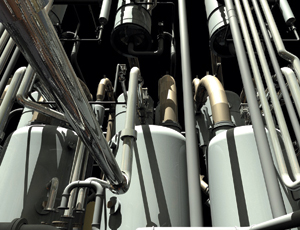For more than 30 years, the oil, gas and chemical process industries have successfully used virtual design and construction to ensure engineering and procurement specifications are in order, and all clashes are resolved before construction begins on the enormous, complex and expensive facilities the industry requires. But VDC, as a planning and construction management tool made necessary by the high stakes and great risks involved in the creation of the plants, turns out to be not enough. Plants are undergoing constant maintenance, refurbishment and change. Keeping on top of the activity and associated data is of vital importance to keep disasters, such as 1988’s Piper Alpha offshore platform explosion, from happening.
Simply collaborating and coordinating around design geometry for construction doesn’t solve the problem, say sources. Bi-directional data flow and access from one application to another, capabilities associated with building, maintaining and running the facility, are required. Data about plant design, operational requirements, maintenance schedules, installed equipment, standby equipment and inventory needs to be readily available. And information needs to move back and forth between engineers, vendors, contractors and owner/operators, regardless of software platforms or products in use.
Data interoperability has become the beacon for the industry, and large pieces of the solution are falling into place, based on a common reference data standard called ISO 15926, quickly being embraced by users and software vendors that support the industry. “They are saying, if a company does not embrace this initiative, they might not be in business in the future,” says Gopal Shastry, head of information systems and CAD at Reliance Engineering Associates (P) Ltd.
The firm’s parent company, Reliance Industries Ltd., is owner-operator of the 7,400-acre Jamnagar petroleum refinery and petrochemical facility in the state of Gujarat, India. Built by Bechtel, San Francisco, and engineered on Intergraph’s plant design system, it is the world’s biggest single-location refinery. Its output is 1.24 million bbl per day.
“Data needs to be moved between different stakeholders,” Shastry says. “The operators and the engineering contractors are all working on this. In a couple of years ISO 15926 will be the de facto standard, and not only in this industry—any industry will be looking for this kind of product,” he predicts.
Sources say data needs to move from engineers to vendors for price quotes, and then, ideally with procurement, it needs to automatically move into an enterprise-wide data management system for operations and maintenance. “We are trying to work out a tool to integrate these various pieces of data,” Shastry says, adding that, “for the owner/operator, there is also the issue of knowledge management and how various departments, such as quality control, safety, maintenance, human resources and finance, can pull data from the same database.”
The plant delivery model traditionally centers around the services of an overall EPC—engineer, procure, construct—contractor, such as Jacobs, Pasadena, Calif.; Fluor, Irving, Texas; CH2M-Hill, Englewood, Colo.; KBR, Houston; Bechtel and others. But the projects are getting so large that owners are starting to break plants into packages distributed among multiple EPCs, says Anne-Marie Walters, global marketing director for Bentley Plant, representing a suite of products by vendor Bentley Systems Inc., Exton, Pa. The Petro-Canada Fort Hills project developing the Alberta oil sands is an example. “They split delivery of this big plant into seven EPC contracts,” which is becoming the norm, she says.
A project boom has caused a shortage of engineering resources. “For owners, it has become impractical to say ‘Everybody use this one particular design solution,’ because there simply aren’t enough people around,” Walters says.
That spawned the need to pull models together. But in some instances, because the lowest common denominator is just the graphics, “you were loosing data and going backward,” says Walters. The adoption of ISO 15926 by software vendors and users as a standard exchange format for the data that underlies the graphics is a direct effort to counteract this.
Data generation starts with the process licenser—chemical engineers who define the processes that the facility’s equipment will need to support, says Ronald G. McLeod, U.S. vice president of leading plant-design software vendor AVEVA Inc., which released Plant Design Management System (PDMS) in 1971. This schematic, 2D, front-end...















Post a comment to this article
Report Abusive Comment